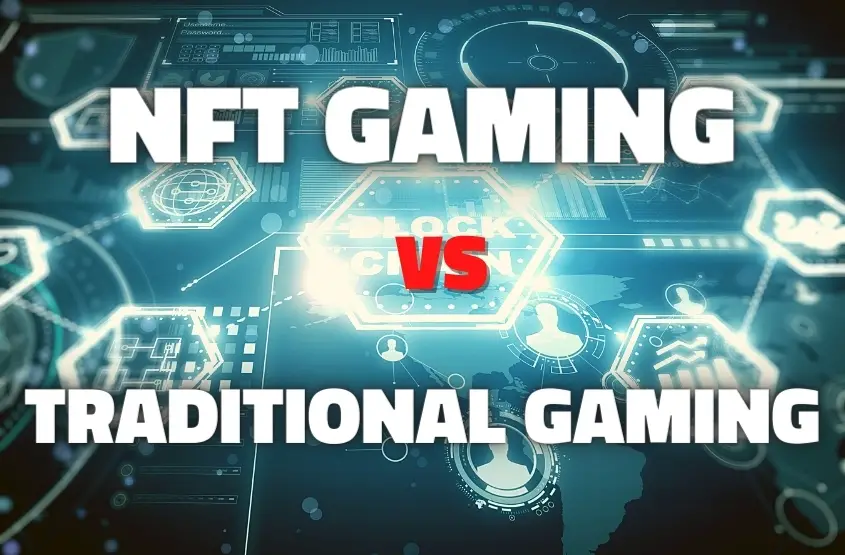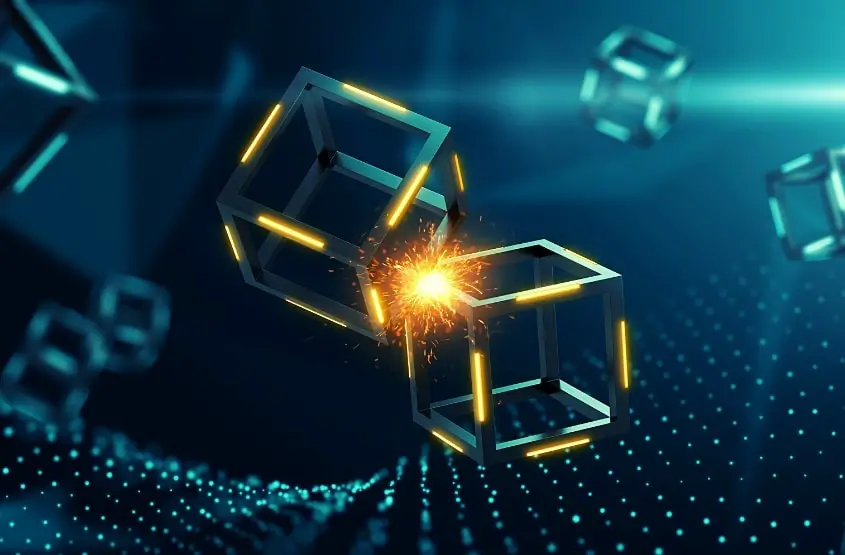NFTs were first popularized as digital art pieces. However, as time goes on you should expect to see more than just non-fungible art. Try NFT gaming for example.
The gaming industry is one of the largest entertainment industries in the world, seeing more revenue than the global movie and North American sports industries combined.
After finding out about NFT gaming, I became extremely curious of what it was and what it entailed. After an interview with the creators of Hexarchia (a revolutionary war & strategy video game) which was created using Unreal Engine and integrated with the blockchain, I found out exactly what NFT gaming is.
What Is NFT Gaming?
NFT gaming or blockchain gaming brings NFT-based economic incentives to players and uses cryptocurrency as a payment solution and reward system for gamers. Players can send, receive and use in-game non-fungible tokens representing the digital identity of their favorite video game characters, items, and assets.
NFT gaming will change the way gamers play games moving forward. Imagine getting paid real cash for defeating your online arch-enemies, this has become a reality with non-fungible token gaming.
Moreover, not only can you buy in-game assets such as your favorite character and all their unique gadgets, you now own them! Thanks to NFTs, you are actually able to own in-game objects and characters which can then be exchanged on decentralized marketplaces that offer high liquidity.
NFTs are good tools to keep track of digital properties and ease buying and selling in the global market without intermediaries. The most amazing thing is the simplicity with which it enables cross-application interoperability. You may buy a character in a video game and then use it on another game. This interoperability of course is not by default, developers must implement it on their application, but thanks to NFTs it has become really an easy and straightforward task. NFTs are helping the gaming industry to pull down the borders and turn video games in a single, large, unified virtual world.
Hexarchia — The New Generation Of Blockchain Video Game.
What Purpose Do NFTs Serve In Gaming?
NFTs serve many purposes and will continue to advance and offer even more in the future. But, what purpose do non-fungible tokens serve in gaming and how can you take advantage of them?
In gaming, NFTs are adopted to represent ownership of in-game assets such as items, characters, and achievements. These NFTs can be bought, sold, and traded on third-party marketplaces and gamers may show off their skill level and achievements via the blockchain ledger.
How Do You Play A Blockchain Video Game?
Trying to figure out exactly how you go about playing a video game that is integrated with the blockchain seems like quite the task in itself. Come to find out, playing a video game on the blockchain is actually really simple. This is how you go about playing a blockchain video game.
In order to play blockchain games you need access to Web 3.0, generally through a plug-in such as Metamask or Dapper Wallet. You may need to purchase cryptocurrency to spend in-game as well, depending on the type of economy architecture implemented. Note, users don’t necessarily need to spend money to play.
As of now, NFT incorporated games are only playable on your browser. However, many blockchain game creators have developed mobile apps that allow you to play blockchain-based games from the palm of your hand and earn cryptocurrency from playing as well.
The Main Advantage Of Blockchain Gaming vs. Traditional Gaming.

Gaming has been around since the late 1950s believe it or not. What started out as a classic game of “Tennis For Two”, is now an entire industry full of creators, gamers, and faithful followers who together, produce annual revenue of over $100 billion. With so much success, you may be wondering why change anything and what is is the difference between traditional gaming vs. blockchain gaming, and what are some advantages of blockchain integrated gaming?
The advantage of blockchain gaming is the fact that you can literally own your in-game assets. Moreover, gamers are able to monetize their hard-earned in-game assets and earn real money as a reward for their ability to play the game. The blockchain will bring a true revolution in competitive games and will improve the user’s satisfaction and affiliation.
Think about it. It’s not much so much a new concept as much as it is a new way to achieve what gamers and their audience desire — a way to be a part of a team and interact while adding more value at the same time. Before, gamers would purchase in-game assets and use them in the game. However, if you stop playing the game then your assets becomes virtually useless. That’s where NFTs come in and literally change the game.
Now, you can take your in-game articles and bring them with you wherever you go, sell them and trade them. This not only benefits the gamer but also the creators of the game who mints and sell these NFTs. Creators can initiate exclusive drops and limited edition in-game items, increasing the overall interaction, value, and excitement experienced when playing a game.
How Much Do Blockchain Games Cost To Play?
Most video games will cost you. Whether you’re downloading an app on your phone or buying one at the store, there is always an upfront cost you have to pay as well as in-game expenses if you are a true advocate. So, how does the blockchain game pricing structure differ from traditional games and how much do blockchain games cost?
Many blockchain games don’t charge an upfront cost, however, some games may require you to buy specific NFTs in order to play which may cost anywhere from $50 to $350 on average. As well, some games are completely free to play and may not require you to purchase anything, although there may be value left on the table if you don’t purchase.
Blockchain-based games may cost you a lot more money overall when taking into consideration the purchase of NFTs. But, you have to remember, you can also earn money playing these games along with selling your NFTs. As a reminder, many games may not charge a dime to play as Hexarchia. So, maybe try starting with the basics if you’re hesitant about this new style of gaming. Otherwise, full steam ahead!
Challenges Of Building Games On The Blockchain.

Although I don’t have the slightest clue how to create video games, I do understand that it takes a lot of hard work, dedication, and time to achieve game users love to play. I asked Hexarchia what challenges they faced while creating the game using Unreal Engine (UE) along with the integration of blockchain technology; here is their answer.
The challenge of creating blockchain integrated games resides in a key layer in the back-end that provides persistence to player data. Usually, this layer is a centralized back-end and UE is specifically designed to interact with such a layer, it offers no blockchain integration out-of-the-box, so you have to work around and create a bridge in between.
With current technology, it’s not possible to build a complete on-chain back-end infrastructure. The difficulty is to find the right balance between them in order to leverage the best of both worlds: the safety and immutability of blockchain on one hand and a seamless and responsive experience of centralized servers on the other.
The incorporation of NFTs hasn’t been a big deal, since there’s already a well-established practice on how to implement them on Ethereum. The important thing is the bridge to interact with Ethereum.
What Is The Future of Blockchain Gaming?
NFTs are likely to pave a new road for many industries in the world, gaming being no exception. So what exactly is the future of blockchain gaming and what should you expect to see?
The future of blockchain gaming includes adding value to the creators, players, and consumers in the gaming industry through the use of NFTs. Also, the security and safety provided by the blockchain add an additional layer of comfort and interaction for gamers and creators alike.
In the future, blockchain gaming will offer a way for you to be a part of the game and actually interact with the virtual world. Top gamers will unlock and collect scarce assets they can own as a badge of honor for their hard work and dedication to the game.
Likewise, the audiences that consume gamers’ content and media will have the opportunity to invest in their favorite players and support them through the purchase of NFTs and other digital assets. In fact, it’s not any different than collecting your favorite sports player’s jersey or card.
The gamer creates underlying value by building a following, then the audience can benefit from the purchase of these valuable assets by selling and collecting them in their personal crypto-wallet.
Looking even further ahead, I predict NFTs and the blockchain will coincide with virtual reality, ultimately creating a fully-functional and interactive online gaming world where you can network with other gamers, display your achievements, and of course play head-to-head against anyone in the world.
Non-fungible tokens will change the way the gaming community plays, consumes, interacts and will add a tremendous amount of value to everyone involved. Welcome to the future of gaming.
“We think NFTs are going to be very big in the gaming industry in the coming future and we are eager about being among the first to adopt it in a truly engaging war & strategy video game built by experienced game designers.”
– Hexarchia

2 thoughts on “What is NFT Gaming? The Future Of Blockchain Video Games”
Comments are closed.